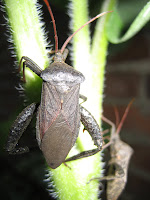At about 4:30 Friday, I was cleaning up after finishing an assay when the sky blackened. Rain poured over the building in sheets. Leaves and trash swirled
upward from the construction site below the window. I headed downstairs, despite the lack of any alarm. It was over in a few minutes. The tornado warning alarms sounded for the next half hour. They may have been going during the storm, but we could not hear them indoors.
On the way home, I saw the usual small branches and leaves littering the road. The electricity was out when I got home, but I called the utility company, and the automated service said it would be up in a few hours.
Hours passed. We went for a walk after dinner at the local cafe, which had power. A few blocks south of us, a huge, mature oak had split from the bottom (roots were shallow and black with rot, though the crown was lush and green) and fallen on a thick north-south power line, crushing a utility pole with the transformer and leaving lines in the road. We learned that this had happened all over the city, with winds up to 70 miles per hour, and a tornado suspected in Bartlett. It travelled up Bartlett Boulevard. It hit densely populated areas along the route. Nobody died, and only a few were injured. About 130,000 people were left without electricity. We bought some dry ice and prepared for the worst.
The trucks started coming and going the next day. The neighborhood echoed with chain saws and generators, but was otherwise strangely quiet. The holes for new poles were being drilled by Saturday afternoon. Police cars with spotlights patrolled the neighborhood all night. Wires were up Sunday, but there were other wires down that had to be fixed before they could safely restore our electricity.
The dry ice was gone by Sunday afternoon, and the refrigerator was getting too warm. We went hunting dry ice, but to no avail. We bought regular ice and hustled all remaining salvageable cold goods into the chest freezer in the garage, packing it full so that it would stay cold.
We grilled a dinner of fresh vegetables and thawing chicken in our smoker/grill. We'll eat a lot of chicken and pork chops in the next few days. Fortunately the meat did not thaw completely.
We learned that we are too dependent on the electric company for our basic needs. Freezing as a sole means of food preservation is not good. We lost a LOT of frozen vegetables. We need a battery or crank-operated radio. I'll be canning a lot of strawberry jam in the next few days, as the strawberries thawed, too (but stayed cold). We need to build our emergency supplies. We will.




















